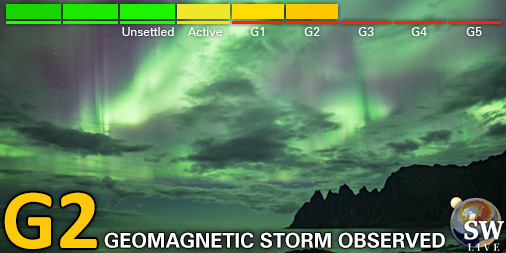Viewing archive of Friday, 18 March 2022
Daily bulletin on solar and geomagnetic activity from the SIDC
Issued: 2022 Mar 18 1231 UTC
SIDC Forecast
Solar flares
C-class flares expected, (probability >=50%)
Geomagnetism
Quiet (A<20 and K<4)
Solar protons
Quiet
| 10cm flux | Ap | |
|---|---|---|
| 18 Mar 2022 | 103 | 007 |
| 19 Mar 2022 | 101 | 007 |
| 20 Mar 2022 | 101 | 014 |
Bulletin
There are four active regions on the visible solar disc. NOAA AR 2965 has decayed into a beta magnetic field configuration, it has decreased in size and produced the only C-class flare of the past 24 hours (C1.0 with peak at 19:18 UT on 17 March). The other regions are small and have simple magnetic field configurations. For the next 24 hours, C-class flares can still be expected.
No Earth directed CMEs were observed in the past 24 hours. The CME from 16 March may arrive to to the Earth on 20 March.
The greater than 10 MeV proton flux was at nominal levels and is expected to remain so in the next 24 hours. The greater than 2MeV electron flux was under the 1000 pfu threshold and is expected to remain so for the next 24 hours. The 24h electron fluence was at normal levels and is expected to remain so in next 24 hours.
The Earth is inside a slow solar wind flow, with solar wind speeds close to 300 km/s and an interplanetary magnetic field magnitude around 5 nT. Similar conditions are expected for the next 24 hours.
The geomagnetic conditions over the past 24 hours were mostly quiet (K_Bel = 1-3 and Kp = 2) . Similar conditions can be expected for the next 24 hours.
Today's estimated international sunspot number (ISN): 033, based on 17 stations.Solar indices for 17 Mar 2022
| Wolf number Catania | /// |
| 10cm solar flux | 103 |
| AK Chambon La Forêt | 008 |
| AK Wingst | 005 |
| Estimated Ap | 004 |
| Estimated international sunspot number | 046 - Based on 17 stations |
Noticeable events summary
| Day | Begin | Max | End | Loc | Strength | OP | 10cm | Catania/NOAA | Radio burst types | |
|---|---|---|---|---|---|---|---|---|---|---|
| None | ||||||||||
Provided by the Solar Influences Data analysis Center© - SIDC - Processed by SpaceWeatherLive
All times in UTC
Current data suggests there is a moderate possibility for aurora to appear at the following high latitude regions in the near future
Gillam, MBCurrent data suggests there is a slight possibility for aurora to appear at the following high latitude regions in the near future
Iqaluit, NU, Saskatoon, SKNuuk
Tórshavn
Reykjavik
Latest news
Latest forum messages
Support SpaceWeatherLive.com!
A lot of people come to SpaceWeatherLive to follow the Sun's activity or if there is aurora to be seen, but with more traffic comes higher server costs. Consider a donation if you enjoy SpaceWeatherLive so we can keep the website online!

Latest alerts
03:15 UTC - Geomagnetic activity
Moderate G2 geomagnetic storm (Kp6) Threshold Reached: 02:59 UTC
01:00 UTC - Geomagnetic activity
Minor G1 geomagnetic storm (Kp5) Threshold Reached: 00:51 UTC
Friday, 4 April 2025
23:30 UTC - Geomagnetic activity
Minor G1 geomagnetic storm (Kp5) Threshold Reached: 23:17 UTC
21:03 UTC - Hemispheric Power Index
The OVATION model predicts the Hemispheric Power Index to reach 75GW at 21:49 UTC
13:15 UTC - Geomagnetic activity
Minor G1 geomagnetic storm (Kp5) Threshold Reached: 13:07 UTC
Space weather facts
| Last X-flare | 2025/03/28 | X1.1 |
| Last M-flare | 2025/04/01 | M2.5 |
| Last geomagnetic storm | 2025/03/27 | Kp5 (G1) |
| Spotless days | |
|---|---|
| Last spotless day | 2022/06/08 |
| Monthly mean Sunspot Number | |
|---|---|
| March 2025 | 134.2 -20.4 |
| April 2025 | 143 +8.8 |
| Last 30 days | 129.8 -16.3 |





